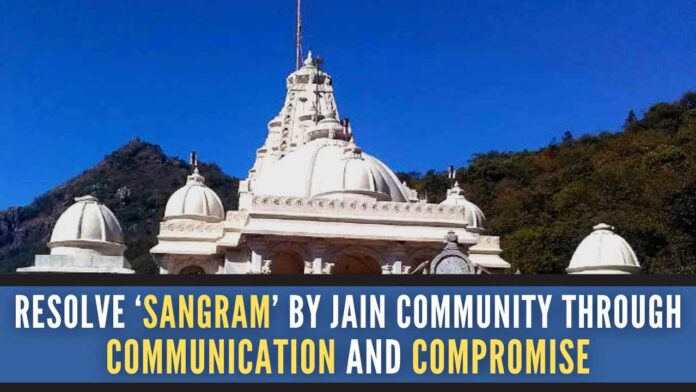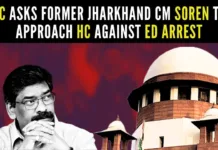
Jharkhand’s Shri Sammed Shikharji shrine issue
Observing fast unto death, Jain Muni Sugyesagar Maharaj gave his life in protest against the Jharkhand government’s decision to develop the Shri Sammed Shikharji as a destination for “religious tourism.” It is one of Jain’s sacred pilgrimage centers. It was equally a penance for Muni ji to purify his soul and attain salvation. While even one death is too many, would it not be wise that the ongoing ‘Sangram’ by Jains be resolved through communication and thoughtful compromise between the Jain community and state government?
For Jains, the temple holds a very special significance because 20 out of 24 Jain Tirthankaras of the current cycle attained salvation there. The estimated 3-crore strong and relatively prosperous Jain community in India fears that the decision will change the character of the religious site. The Jains all across India are up in arms with huge protests in the streets of dozens of cities including Delhi, Mumbai, Ahmedabad, Bhopal, Surat, and more. They are seeking the government to rescind its decision for religious tourism at the holy site and thus draw a hard line.
In all fairness, neither the Jain community is wrong in wanting to preserve and protect the sanctity of Shri Sammed Shikharji but nor is the government for the regional development which will ease the travel for pilgrims. Our discussion is centered on the plausible solution to calm the confrontation between the Jain community and the Jharkhand government. What role Modi government can play to avert the political fallout with opportunists like Owaisi making it a religious minority versus majority Hindus? Owaisi, the politician, has his deep seeded sinister motives to bring back the minority Muslims in the discussion.
Shri Sammed Shikharji is situated at Parasnath Hills. For Jains, the temple is so sacred that believers from all across the world climb about 27 kilometers to reach the peak. While I have never been there, I can relate to other Hindu religious sites often requiring treacherous and difficult trekking which people have undertaken for ages. What comes to mind immediately is Mata Vaishnav Devi temple in Jammu which I visited a couple of years ago. It requires nearly 12 km of trekking from the base camp at Katra which many hard-core believers, the young and old, climb religiously. Others use horse rides along the way yet many like me in the seventies did not dare do either. I used the third alternative- a helicopter flight to and from Katra which still required a significant uphill walk to the Devi shrine. I know for a fact that many would not be able to visit Mata Vaishnava Devi unless other means of transport and reasonable facilities around the temple were available.
The state government proposal, as I understand, includes a helipad to ease travel for those (particularly the seniors and physically less abled) who otherwise may not be able to navigate the peak and/ or have limited time for the pilgrimage. The government plan also includes the construction of a Theme Park, Tourism Reception Centre, Car parking, and Bus stand in Madhuban town, at the foot of the Parasnath Hills. In this day and age, I believe, the pilgrims need and want reasonable accommodations, eating places, health and sanitary facilities, and other amenities along the trekking route and at the hill. One of many fears raised by the Jains, and rightly so, is the potential for alcohol, meat, other objectionable materials, and rogue elements in society to make their way to the site of the holy shrine. It is their belief that such occurrences will reduce the sanctity of the temple.
It is my view that such fears can be alleviated through amicable but open-minded discussions and mutual consultations between the Jain leadership and administration. I cannot imagine that strict vigilance and enforcement against alcohol, meat, and other items cannot be achieved. To the best of my knowledge, Vaishnav Devi has strict guidelines and ways to enforce them.
The temple site including a 10 km area around it is declared Eco-Sensitive Zones (ESZ) which minimizes urbanization and other developmental activities. Jain community, however, fears that ESZ classification does not stop the place from being turned into a tourist spot. Jharkhand government is clearly taking advantage of the loophole in the ESZ guidelines by the Central government.
It is my informed view that most confrontations arise because of the lack of communication, consultation, hard attitudes, and unwillingness to reach compromises. The state government cannot be entirely blamed for the regional development such as the Madhuban town with expanded employment and business opportunities. The government is equally responsible for the safe passage and well-being of pilgrims of all ages and different physical abilities. The fears expressed by the Jain community cannot be totally ruled out either. The solution then is that both parties engage in meaningful dialog, make a comprehensive list of issues, seek reasonable solutions, study what is being done in other places of worship like Vaishnav Devi, and implement strategies that will foster development without compromising the sanctity of Shri Sammed Shikharji.
I am afraid that the long-drawn protests in the street will simply make the issue more complex. In that, the opportunists like Owaisi jumping into the fray will make the issue more volatile turning it into Jains as a religious minority against Hindus. Owaisi has only one objective which is a divided and unstable India. I fully believe that the well-intentioned Jain community, an integral part of Sanatan Dharma, never wanted their issue to get politicized and Jains to stand at odds with the Hindus.
There is also the fact that the Santhal tribe in Jharkhand holds an annual festival at the hills each year in April. The state government also has plans to construct a Marang Buru Temple for the local tribes. It is perhaps to fulfill the demand by the local tribes and an effort to strengthen the vote bank for the local politicians. I don’t know if the Jain community has any reservations on this count but I hope that they would honor tribal religious beliefs as they do their own.
It is very unfortunate that Jain Muni Sugyesagar Maharaj had to give up his life. I heard Jharkhand Chief Minister that he needs more time to fully understand the issues and demands of the Jain community. I have no doubt that even Prime Minister Modi and his team are working behind the scenes to have the issue resolved amicably. The New India is already faced with communal and religious strife and no one in their right mind would wish for more.
As we say, where there is a will there is a way. Therefore, I sincerely urge the Jain community known for their cardinals of Ahimsa (non-violence) and Satya (truthfulness) to stop street demonstrations. Having many Jain friends, I know in my heart that the Jain community would never want confrontation and politicization of what can be achieved through friendly and peaceful dialog, communication, and reasonable compromises. Let us believe in Satyamev Jayate and move forward.
Note:
1. Text in Blue points to additional data on the topic.
2. The views expressed here are those of the author and do not necessarily represent or reflect the views of PGurus.
PGurus is now on Telegram. Click here to join our channel and stay updated with all the latest news and views
For all the latest updates, download PGurus App.
- An Eye for an Eye (Israel-Iran conflict) and role of the Third Eye (India) - April 29, 2024
- Education and election in Bharat: Race to the top - April 16, 2024
- Kejriwal: “An Insignificant Man” or a corrupt politician with impending prison term - March 24, 2024










